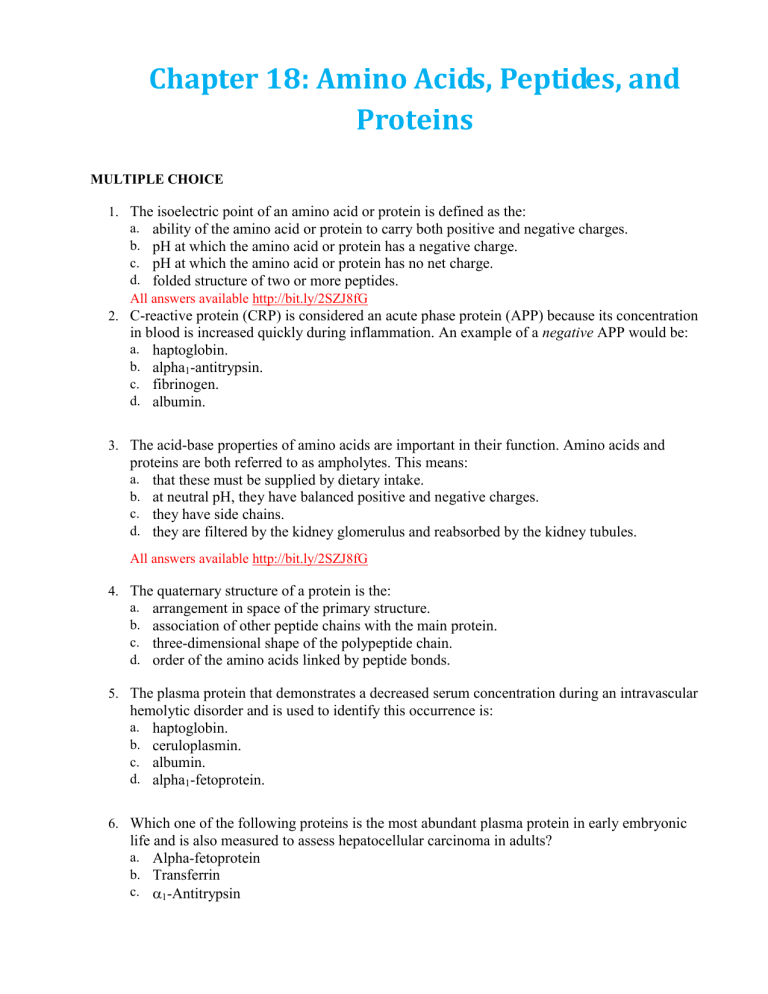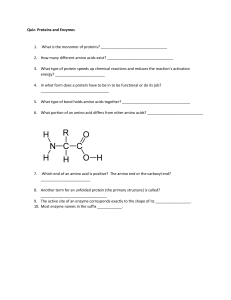
Chapter 18: Amino Acids, Peptides, and Proteins MULTIPLE CHOICE 1. The isoelectric point of an amino acid or protein is defined as the: a. ability of the amino acid or protein to carry both positive and negative charges. b. pH at which the amino acid or protein has a negative charge. c. pH at which the amino acid or protein has no net charge. d. folded structure of two or more peptides. All answers available http://bit.ly/2SZJ8fG 2. C-reactive protein (CRP) is considered an acute phase protein (APP) because its concentration in blood is increased quickly during inflammation. An example of a negative APP would be: a. haptoglobin. b. alpha1-antitrypsin. c. fibrinogen. d. albumin. 3. The acid-base properties of amino acids are important in their function. Amino acids and proteins are both referred to as ampholytes. This means: a. that these must be supplied by dietary intake. b. at neutral pH, they have balanced positive and negative charges. c. they have side chains. d. they are filtered by the kidney glomerulus and reabsorbed by the kidney tubules. All answers available http://bit.ly/2SZJ8fG 4. The quaternary structure of a protein is the: a. arrangement in space of the primary structure. b. association of other peptide chains with the main protein. c. three-dimensional shape of the polypeptide chain. d. order of the amino acids linked by peptide bonds. 5. The plasma protein that demonstrates a decreased serum concentration during an intravascular hemolytic disorder and is used to identify this occurrence is: a. haptoglobin. b. ceruloplasmin. c. albumin. d. alpha1-fetoprotein. 6. Which one of the following proteins is the most abundant plasma protein in early embryonic life and is also measured to assess hepatocellular carcinoma in adults? a. Alpha-fetoprotein b. Transferrin c. 1-Antitrypsin d. Ceruloplasmin 7. Hyperproteinemia is caused by: a. gastrointestinal disease. b. liver disease. c. kidney disease. d. dehydration. All answers available http://bit.ly/2SZJ8fG 8. An increase in Bence-Jones protein in urine typically indicates the presence of paraproteins. What is Bence-Jones protein? a. An alpha2-globulin similar to C-reactive protein b. Immunoglobulin light chain fragments c. An acute phase reactant protein that appears during an infection d. Another name for IgM that activates complement 9. Which one of the following statements concerning albumin is not correct? a. Albumin is the most abundant protein in plasma. b. Albumin transports many substances in plasma. c. Albumin is a negative acute phase protein. d. Albumin is involved in plasma reduction and oxidation reactions. 10. Known functions of proteins normally present in plasma include all of the following except: a. buffering. b. emulsification of fat. c. transport of iron and copper. d. oxygen transport. 11. The serum protein that is analyzed to determine the presence of emphysema is: a. alpha1-antitrypsin. b. ceruloplasmin. c. alpha fetoprotein. d. haptoglobin. 12. Which of the following proteins are important in the regulation of circulating iron? a. Haptoglobin b. Ceruloplasmin c. Transferrin d. Both b and c All answers available http://bit.ly/2SZJ8fG 13. You operate a laboratory that receives many patient samples from the renal clinic next door. These patients have serious kidney problems, with causes that range from diabetes and IgA nephropathy to Fanconi syndrome. Would you expect to see elevated or decreased total urine protein from the patients that go to this clinic? a. Elevated b. Decreased 14. Albumin concentration in blood can be analyzed in an empty blood collection tube containing no anticoagulant. This means that you are analyzing: a. serum that has been obtained when no anticoagulants are mixed with whole blood and then centrifuged. b. plasma that has been obtained when no anticoagulants are mixed with whole blood and then centrifuged. c. serum that has been obtained by mixing anticoagulants with whole blood and then centrifuged. d. plasma obtained by mixing anticoagulants with whole blood and then centrifuging the sample. 15. Serum proteins or protein complexes that precipitate at temperatures lower than normal core body temperature and that, if precipitated in tissues, result in vasculitis and ischemic injury to peripheral tissues are referred to as: a. essential amino acids. b. paraproteins. c. amyloids. d. cryoglobulins. 16. At a physiological pH of 7.4, most amino acids: a. are positively charged. b. have no net charge. c. are negatively charged. d. precipitate out of solution. 17. At a pH of 4.0, the: a. carboxyl and amino groups of an amino acid become unprotonated, causing the amino acid to have a net negative charge. b. carboxyl and amino groups of an amino acid become protonated, causing the amino acid to have a net positive charge. c. carboxyl group of an amino acid is dissociated and the amino group is protonated, giving the amino acid no net charge. d. amino group of an amino acid is dissociated and the carboxyl group is protonated, giving the amino acid no net charge. 18. The element of protein structure that involves the folding of the polypeptide in three dimensions and the formation of disulfide bonds between cysteines is the _____ structure. a. primary b. secondary c. tertiary d. quaternary 19. Refractometry is a rapid, semiquantitative method of total protein determination. Which of the following will lead to a faulty interpretation of protein values obtained by refractometry? a. Serum protein less that 3.5 g/dL b. Lipemia c. Bilirubinemia d. All of the above All answers available http://bit.ly/2SZJ8fG 20. Immunofixation electrophoresis: a. combines the techniques of zone electrophoresis, isotachophoresis, isoelectric focusing, and gel electrophoresis in small-bore fused silica capillary tubes. b. involves exposure of electrophoresed proteins to antisera against different immunoglobulin heavy and light chains with resultant precipitation. c. involves transfer of separated proteins to a strip of nitrocellulose by electroblotting followed by an immunochemical reaction with a specific antibody. d. uses electrophoresis in two dimensions to assess global changes in protein expression. 21. A malignant neoplasm that is composed of plasma cells that exhibit monoclonality and are diffusely present in the bone marrow is referred to as: a. multiple sclerosis. b. monoclonal immunoglobulinemia. c. multiple myeloma. d. plasmacytoma. 22. The addition of sulfosalicylic acid for a qualitative turbidimetric protein determination of a urine specimen is done to: a. dilute the protein in the specimen, because it is typically high and beyond the range of standards. b. remove interfering substances from the specimen. c. increase the volume of the specimen, because it is difficult to obtain adequate volume. d. precipitate a protein in the specimen that might be missed by albumin urine dipstick methods. 23. Analyses of free light chains, particularly immunoassays that measure the ratio of free - to free -light chains, are sensitive indicators of: a. disorders of immunoglobulin synthesis such as multiple myeloma. b. albumin increase such as that observed in dehydration. c. -globulin disorders such as decreased LDL. d. increased C-reactive protein such as that observed following myocardial infarction. 24. The reference method for protein determination that converts nitrogen to ammonium ions by acid digestion is the: a. biuret method. b. refractometry method. c. Kjeldahl method. d. absorption of light at 280 nm. 25. The proteins that are deposited in tissues as aggregates and that form -sheet structures with eventual damage to the tissues are referred to as: a. paraproteins. b. complement proteins. c. amyloid. d. Bence-Jones protein. All answers available http://bit.ly/2SZJ8fG 26. A healthy 27-year-old pregnant woman in the second trimester sees her obstetrician for a routine visit. Blood and urine samples are obtained. Total serum protein and protein electrophoresis are performed on the blood sample and total urine protein is also analyzed. The results of the serum protein electrophoresis indicate a substantial increase in the -globulin region of the electrophoretogram. Which of the -globulins might this be and why? a. It is likely alpha1-antitrypsin because of the presence of increased surfactant. b. It is likely alpha2-macroglobulin because of decreased serum estrogen. c. It is likely alpha1-acid glycoprotein because of the presence of progesterone. d. It is likely alpha1-fetoprotein due to fetal development. 27. A tumor of plasmacytoid cells that is diagnosed as Waldenström macroglobulinemia produces a paraprotein that is an: a. IgA. b. IgE. c. IgG. d. IgM. 28. The most abundant complement protein component that is common to all three pathways of complement is: a. C1. b. C3. c. C5. d. C7. 29. What is the globulin concentration of a specimen given the following information: total protein, 6.5 g/dL, and albumin, 3.8 g/dL? a. 2.7 g/dL b. 10.3 g/dL c. 1.7 g/dL d. You cannot determine the globulin concentration from the information given here. All answers available http://bit.ly/2SZJ8fG MATCHING Using each answer only once, match the metabolic disorder with the related plasma protein abnormality. a. Wilson disease b. Intravascular hemolysis c. Inflammation d. Chronic renal disease 1. 2. 3. 4. Elevated serum C-reactive protein Elevated retinol-binding protein Decreased serum ceruloplasmin Decreased haptoglobin





